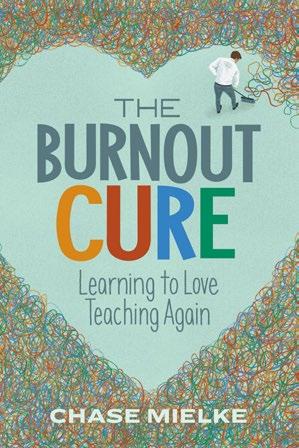
4 minute read
Book Review: The Burnout Cure
Book Review
Review by Christina Ordonez
The Burnout Cure: Learning to Love Teaching Again
by Chase Mielke
Click the cover to view on ASCD.

Close your eyes and think of that moment, or maybe moments, when you made the decision to be an educator. We entered the profession with passion and a desire to make a difference. However, circumstance or time or both may melt away the candle of our passion and what was once a light in our lives—being an educator—is what is now burning us out. When that burnout occurs, the capacity for excellent culture diminishes.
In a year when it feels like more teachers and administrators are feeling burnt out and contemplating leaving the profession than ever before, Chase Mielke’s book, The Burnout Cure: Learning to Love Teaching Again, may be one of the most important books you can read for yourself or work through with colleagues. It has a personal and uplifting tone that pairs well with the well-researched SEL and psychological principles, but most importantly, it suggests opportunities to embrace Mielke’s Empowered Thriving Model for continuing your love of teaching or finding it once more.
Often, books seem written for specific educational audiences: elementary school teachers, secondary school teachers, administrators or school leadership, and the general public. The beauty of The Burnout Cure is that while some aspects
With the flexibility of a Choose-Your-OwnAdventure novel, The Burnout Cure allows for snippets of research, personable examples, critical questions, and applicable actions to be pulled for individual or group use in any order, with each element enhancing the rest.
are angled towards classroom teachers, most can be used by anyone.
The structure of the book itself is one of the most unique and helpful aspects of it. With the flexibility of a ChooseYour-Own-Adventure novel, The Burnout Cure allows for snippets of research, relatable examples, critical questions, and applicable actions to be pulled for individual or group use in any order. Each element enhances and builds on the others allowing educators who are feeling burnt out to chunk the advice for timely and quick access.
The book describes three main elements that Mielke introduces on pages 4-5: • Awareness - ability to “know and see certain things that we didn’t see previously” • Attitude - how “we frame and feel” about teaching • Action - specific changes we can make Each chapter is labeled with one of these elements allowing the readers to explore based on their own needs.
A quote sets the tone and the opening of each chapter and is followed by reflective questioning, research, and explanation of how to fight burnout using that chapter’s lens. Not only is the writing accessible, but it has a variety of resources included for a deeper dive into the topic. Following this narrative is what Mielke calls “Life Assignments.” The Life Assignments are specific actions and reflections one can complete to develop within that chapter’s lens. In fact, many of the Life Assignments are appropriate and would provide value to educators and non-educators at any level. The assignments—such as those on mindfulness, optimism, empathy, altruism, and gratitude—guide readers to be better members of society, friends, partners, and parents, as well as educators. They ignite the passion and the purpose in life. At
the end of each chapter, Mielke himself reflects on his own process, finalizing each chapter with a personal touch, positivity, and optimism.
One of my favorite Life Assignments is called “Craft the Why” (pg. 164). For those of us who have been educators for a while and have become leaders within our schools, we oftentimes are so caught up in the daily tornado of tasks that we forget the “Why.” No one moves into administration because they are excited about more meetings and more paperwork. When we get caught up in the minutiae of leadership, those “Why” reasons fade from view. This chapter serves as a reminder to strengthen our fortitude on those days that are not what we envisioned. It also helps to reframe and prioritize, allowing us to focus on the bigger picture when the details seem overwhelming. And yes, while this is an example for experienced administrators in the educational system, being able to prioritize and recognize what is in your control and outside of your control is also a skill that new educators desperately need in order to prevent burnout in the first years of service. Like any good educator, Mielke doesn’t just think of the book’s use in the moment, but how its lessons can spread and connect to other areas in your life. This includes having an extended appendix area that helps teachers to weave the lessons they are learning through the book into lessons with their students. It suggests Altruistic Acts for Educators. It includes resources beyond the references in the book to provide practical personal and professional well-being.
Creating a positive culture in your school hinges on the engagement of your staff. When teachers and administrators feel purposeful, they are galvanized to share their passion for education. For Professional Learning Teams, this book can be used effectively as a book study, to add notes to a newsletter, or for small, quick, well-being exercises throughout the year, helping to set a strong foundation for positive culture.
I would encourage all educators at any level of experience and with any job description to have this book on their shelf. Even if you don’t feel you need it today, inevitably there will be a moment where you question why you decided to be an educator. Mielke states, “Maintaining the fire for education hinges upon our choices – whether we let the flame burn out or take action to refuel” (pg. 169). The Burnout Cure helps you to recall the passion that you had for education and raises you up to help others reignite theirs.










